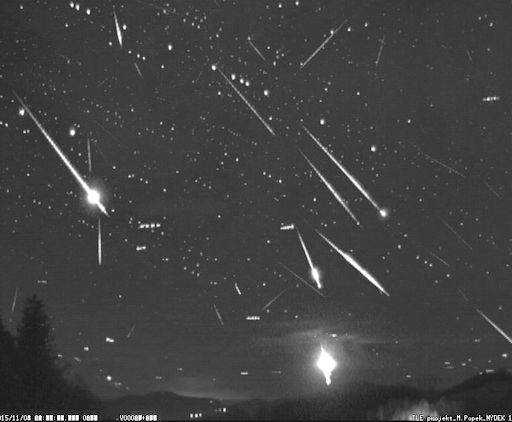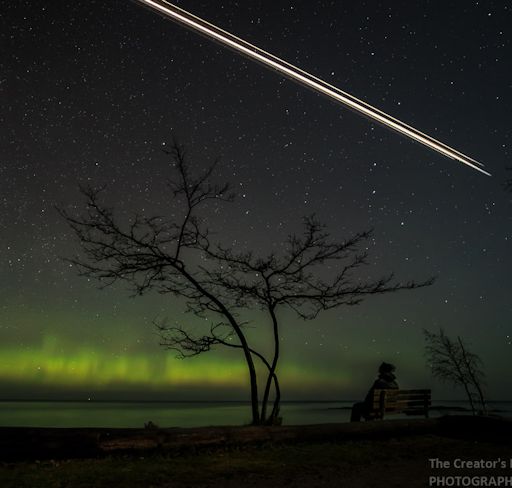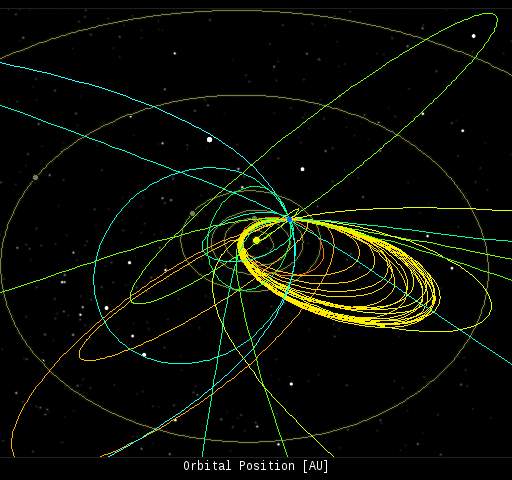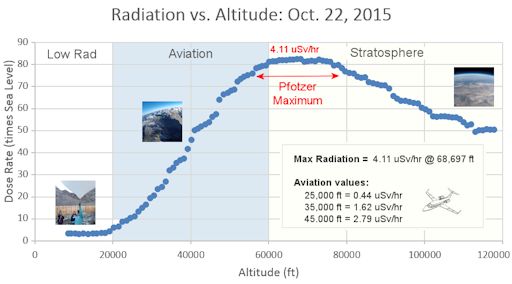Marianne's Heaven On Earth Aurora Chaser Tours Chasethelighttours.co.uk invites you to join them in their quest to find and photograph the Aurora Borealis. Experience the winter wonderland in the Tromsø Area. | | | THE CME HAS ARRIVED: Arriving almost a full day earlier than expected, a CME struck Earth's magnetic field on Nov. 6th at approximately 18:00 UT. G1-class geomagnetic storms are possible in the hours ahead as Earth moves into the turbulent wake of the solar storm cloud. Monitor the realtime photo gallery for aurora sightings. Aurora alerts: text or voice TAURID FIREBALLS: There is no longer any doubt. Earth is passing through a stream of gravelly debris from Comet Encke, source of the annual Taurid meteor shower. Meteoroids the size of pebbles, and larger, are disintegrating as they hit our planet's atmosphere at 30 km/s. To see what effect this is having on the night sky, Martin Popek of Nýdek (Czech republic) activated a low-light camera in his backyard and let it run all night on Nov. 4th. This is what it recorded: 
There were almost a dozen exploding meteors--all brighter than Venus and one as bright as a crescent Moon. "It was a very active night," says Popek. Earth runs unto the debris zone of Comet Encke every year around this time. Usually, the encounter produces a minor meteor shower, but 2015 is different. "This is higher than usual activity," says meteor expert Peter Brown of the University of Western Ontario. "The Canadian Meteor Orbit Radar (CMOR) is seeing stronger Taurid activity than any of the last few years. Our Southern Ontario Meteor Network cameras caught 54 Taurid fireballs from Oct 31 - Nov 4 alone, compared to 22, 18, and 32 Taurids for the entire month of November in 2014, 2013 and 2012 respectively." These extra fireballs are coming from a "swarm" of gravelly meteoroids that weaves in and out of Comet Encke's dusty debris zone. In some years, Earth hits the swarm; in other years it misses. 2015 appears to be a hit. "I would say with some confidence the 2015 Taurid 'swarm' is active as predicted by astronomer David Asher," adds Brown. If those predictions continue to be correct, the fireball display could carry on until Nov. 10th. The best time to look, no matter where you live, is during the hours around local midnight when the constellation Taurus is high in the sky. [meteor radar] Realtime Taurid Photo Gallery MILITARY SATELLITE RE-ENTRY: The Taurid meteor shower is active, but not every fireball is a Taurid. Paul Nelson was watching the auroras over Marquette, Michigan, on Nov. 4th when he saw strange lights overhead. "There were between 10 and 20 objects of some type flying slowly across the sky from West to East and burning up upon entering the atmosphere," says Nelson. "Fortunately one of my cameras captured it." 
"It was one of the strangest things I've ever witnessed," he adds. Observers in Minnesota, Wisconsin and other parts of Michigan witnessed a similar display. Satellite expert Ted Molczan explains what they saw: "The passage of the trail through the bowl of the Big Dipper in Nelson's photo closely matches my estimate of the re-entry trajectory of NFIRE, a military satellite that decayed on Nov. 4th." NFIRE, short for the Near-Field Infrared Experiment, was launched in 2007 aboard a Minotaur rocket from Wallops Island, Virginia. Its mission for the U.S. Missile Defense Agency was to monitor missile launches and collect data on exhaust plumes from rockets. Originally, NFIRE was supposed to carry a demonstration kill vehicle for anti-missile defense. Before launch, however, that aspect of the mission was abandoned and NFIRE went to space without a projectile experiment. NFIRE was retired in August 2015 after more than 8 years in space. Realtime Space Weather Photo Gallery Realtime Aurora Photo Gallery
Realtime Meteor Photo Gallery Every night, a network of NASA all-sky cameras scans the skies above the United States for meteoritic fireballs. Automated software maintained by NASA's Meteoroid Environment Office calculates their orbits, velocity, penetration depth in Earth's atmosphere and many other characteristics. Daily results are presented here on Spaceweather.com. On Nov. 6, 2015, the network reported 39 fireballs.
(20 sporadics, 19 Northern Taurids)  In this diagram of the inner solar system, all of the fireball orbits intersect at a single point--Earth. The orbits are color-coded by velocity, from slow (red) to fast (blue). [Larger image] [movies] Potentially Hazardous Asteroids ( PHAs) are space rocks larger than approximately 100m that can come closer to Earth than 0.05 AU. None of the known PHAs is on a collision course with our planet, although astronomers are finding new ones all the time. On November 6, 2015 there were potentially hazardous asteroids. Notes: LD means "Lunar Distance." 1 LD = 384,401 km, the distance between Earth and the Moon. 1 LD also equals 0.00256 AU. MAG is the visual magnitude of the asteroid on the date of closest approach. | | Cosmic Rays in the Atmosphere | | Situation Report -- Oct. 30, 2015 | Stratospheric Radiation (+37o N) | | Cosmic ray levels are elevated (+6.1% above the Space Age median). The trend is flat. Cosmic ray levels have increased +0% in the past month. | | Sept. 06: 4.14 uSv/hr (414 uRad/hr) | | Sept. 12: 4.09 uSv/hr (409 uRad/hr) | | Sept. 23: 4.12 uSv/hr (412 uRad/hr) | | Sept. 25: 4.16 uSv/hr (416 uRad/hr) | | Sept. 27: 4.13 uSv/hr (413 uRad/hr) | | Oct. 11: 4.02 uSv/hr (402 uRad/hr) | | Oct. 22: 4.11 uSv/hr (402 uRad/hr) | These measurements are based on regular space weather balloon flights: learn more. Approximately once a week, Spaceweather.com and the students of Earth to Sky Calculus fly "space weather balloons" to the stratosphere over California. These balloons are equipped with radiation sensors that detect cosmic rays, a surprisingly "down to Earth" form of space weather. Cosmic rays can seed clouds, trigger lightning, and penetrate commercial airplanes. Our measurements show that someone flying back and forth across the continental USA, just once, can absorb as much ionizing radiation as 2 to 5 dental X-rays. Here is the data from our latest flight, Oct. 22nd: 
Radiation levels peak at the entrance to the stratosphere in a broad region called the "Pfotzer Maximum." This peak is named after physicist George Pfotzer who discovered it using balloons and Geiger tubes in the 1930s. Radiation levels there are more than 80x sea level. Note that the bottom of the Pfotzer Maximim is near 55,000 ft. This means that some high-flying aircraft are not far from the zone of maximum radiation. Indeed, according to the Oct 22th measurements, a plane flying at 45,000 feet is exposed to 2.79 uSv/hr. At that rate, a passenger would absorb about one dental X-ray's worth of radiation in about 5 hours. The radiation sensors onboard our helium balloons detect X-rays and gamma-rays in the energy range 10 keV to 20 MeV. These energies span the range of medical X-ray machines and airport security scanners. | | The official U.S. government space weather bureau | | | The first place to look for information about sundogs, pillars, rainbows and related phenomena. | | | Researchers call it a "Hubble for the sun." SDO is the most advanced solar observatory ever. | | | 3D views of the sun from NASA's Solar and Terrestrial Relations Observatory | | | Realtime and archival images of the Sun from SOHO. | | | from the NOAA Space Environment Center | | | the underlying science of space weather | | 
